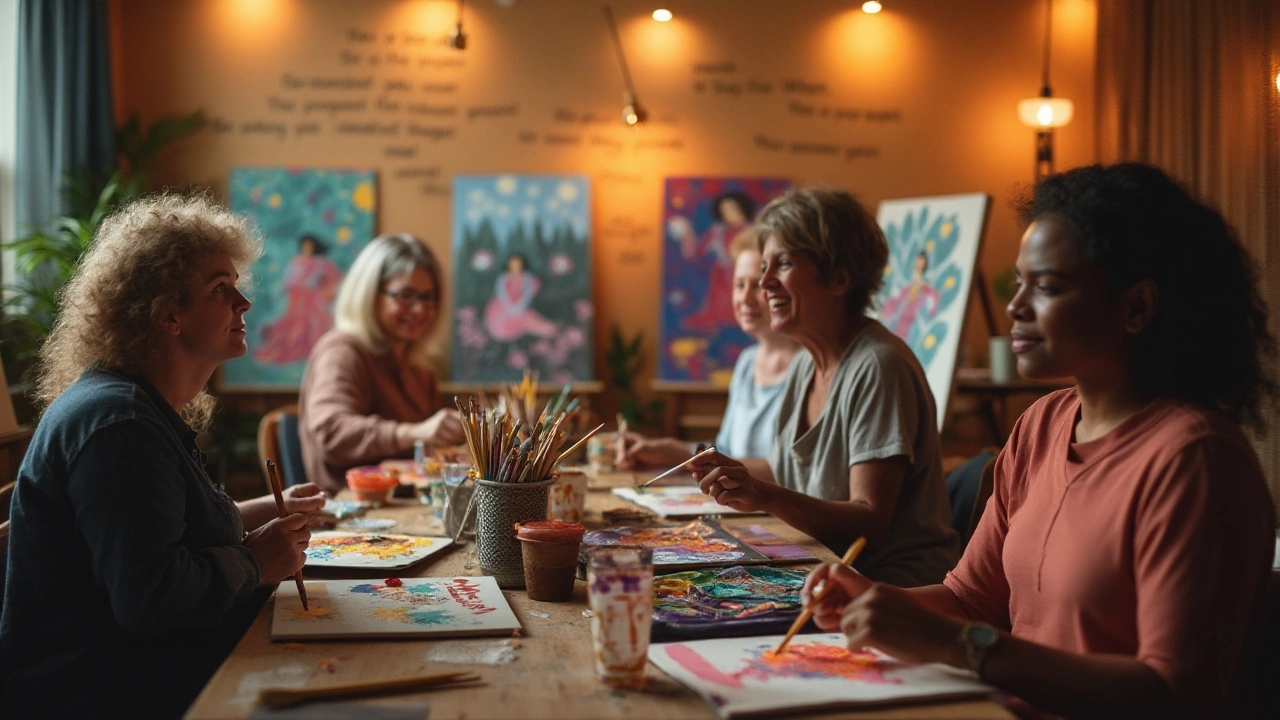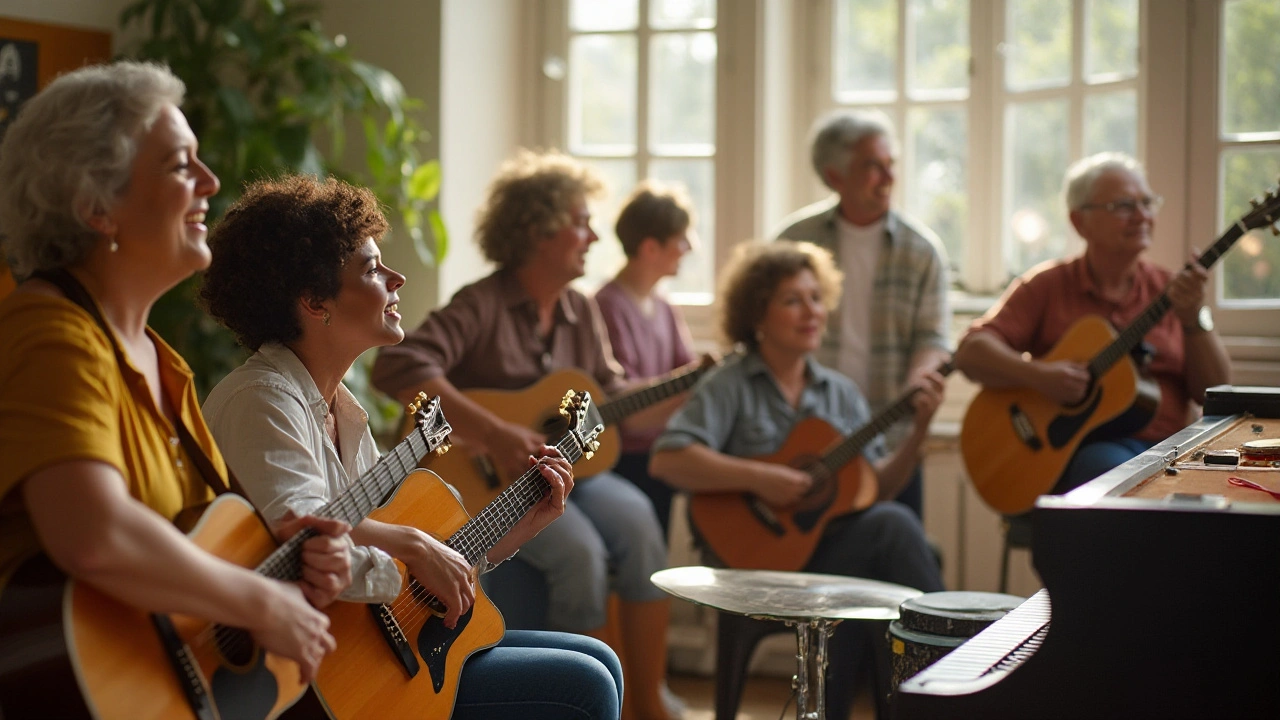
The world of therapy has evolved significantly with the introduction of creative arts therapies, which are rapidly gaining recognition for their positive impact on mental health. Unlike traditional therapy that may rely heavily on dialogue, these therapies explore the expressive potential of various art forms to engage individuals in their recovery process.
Such creative avenues open doors for those who find it challenging to verbalize their inner thoughts and feelings, offering a safe space to express what can be so hard to articulate. From the rhythmic beats in music therapy to the vibrant colors in art therapy, each form provides a unique means to confront and manage complex psychological issues.
These therapies have proven especially beneficial in addressing anxiety, depression, trauma, and even chronic pain by tapping into the innate creative impulses present within everyone. By fostering an environment that encourages creativity, patients often uncover deep-seated insights and achieve emotional breakthroughs that significantly enhance their quality of life.
- Understanding Creative Arts Therapies
- Different Forms of Creative Arts Therapies
- Benefits for Treating Anxiety and Depression
- Case Studies and Success Stories
- How to Integrate Creative Arts into Therapy
- Future Trends in Creative Arts Therapies
Understanding Creative Arts Therapies
Creative Arts Therapies encompass a diverse range of modalities including art, music, dance, drama, and writing therapies, each designed to cater to different aspects of human expression and healing. At its core, this therapeutic approach believes in the potential of creativity as a powerful catalyst for mental health recovery. By translating emotions and thoughts into artistic expressions, patients find avenues to process their internal world safely. Creative Arts Therapies are rooted in the idea that the act of creation itself can lead to transformation, providing a mirror to one’s psyche and a path to healing.
Research in mental health has increasingly highlighted the significance of non-verbal modalities, particularly for individuals who experience challenges in articulating their emotional experiences through words alone. Studies have shown that engaging in art-making, for instance, can lower stress levels and stimulate the brain's reward pathways, creating a sense of well-being. In music therapy, the rhythm and melody can resonate with the ins and outs of emotional life, offering solace and inspiration to delve deeper into one’s feelings. Such therapies can significantly reduce symptoms of anxiety and depression through structured yet fluid exercises that aim to harness the therapeutic potential of these art forms.
A remarkable study by the American Journal of Public Health highlighted that those who participated in weekly creative arts therapy sessions showed significant improvement in emotional expressiveness and decreased levels of psychological distress. While the traditional model of therapy heavily relies on verbal communication, these therapies allow patients to engage in the healing process creatively, which in itself becomes an empowering act of self-care and self-discovery.
"Engagement in creative processes in a therapeutic context offers patients alternative ways to express themselves, potentially leading to improved mental health outcomes." — American Art Therapy Association
The versatility of creative arts therapies means they can be adapted to individual needs, making them an inclusive option for diverse groups. Whether it’s through the evocative power of colors on a canvas, the transformative narrative of drama therapies, or the lyrical dance movements that tap into the body's memory, creative arts therapies provide a holistic path to mental health.
As practitioners grow more adept in these therapies, integrating current technology with traditional art forms is becoming increasingly common. Digital art and virtual reality in therapy are frontrunners in offering immersive environments for patients. This innovation in treatment proves particularly effective with a younger tech-savvy generation, who often find these forms more engaging and accessible. The integration of such emerging resources is leading to new strides in making therapy both enticing and impactful, allowing a greater reach in the effective treatment of psychological disorders. The understanding and application of such therapies continue to expand, showing promising potential in transforming mental health care in the modern era.
Different Forms of Creative Arts Therapies
Creative arts therapies encompass a broad range of modalities, each tapping into different aspects of creativity to foster healing and self-discovery. At the heart of these therapies is the belief that artistic expression can serve as a powerful conduit for emotions, helping to navigate complexities of psychological disorders in ways words alone might not. Among the varied forms, art therapy, music therapy, dance/movement therapy, drama therapy, and expressive writing stand out as prominent practices, each with unique benefits and methods of application.
Art therapy often involves the use of paints, clay, and other materials that allow individuals to explore their emotions visually, providing insight into their psyche. This form of therapy lets patients express feelings they may not yet have words for, helping them process trauma, reduce anxiety, and build resilience. Many therapists have noted how colors and textures can unlock memories and emotions, facilitating deeper understanding and healing. In art therapy sessions, the focus is not on creating a masterpiece but on the process and emotional insights that emerge during creation.
Meanwhile, music therapy leverages the universal language of music. Here, both listening to and creating music are used as therapeutic tools. It’s well-documented that music can alter mood and emotions, ease feelings of depression, and help individuals express hidden thoughts. Techniques include songwriting, instrument playing, and even body rhythm exercises. According to the American Music Therapy Association, music can induce significant changes in stress levels, often leading to improved mental well-being.
"Music acts like a magic key, to which the most tightly closed heart opens," said Maria Augusta von Trapp, emphasizing music's healing power.
Another engaging form is dance/movement therapy, which uses the body’s movement as a tool for healing. This therapy helps individuals express emotions physically, deepening their connection between the mind and body. Movements can convey complex emotions and narratives that verbal expression might miss. It's particularly beneficial for those who might feel societal pressure to conform to norms, as the freedom of movement can be liberating, offering a physical outlet for stress and anxiety.
In drama therapy, the performing arts are called upon to facilitate growth and healing. Role-playing, storytelling, and dramatization are used, helping patients explore different perspectives and solutions to personal challenges. This approach is especially effective for children and adolescents dealing with trauma, as it provides a safe space to express and analyze their experiences. Drama therapy can significantly boost self-esteem and social skills by encouraging participants to step outside their comfort zones.
Finally, expressive writing offers a powerful way for individuals to process thoughts and emotions through written words. Journaling and reflective writing can be incredibly therapeutic, allowing the writer to confront and articulate their innermost feelings. Studies have shown that writing about traumatic or stressful events can lead to reductions in physical and psychological distress. It’s not about grammatical perfection but about the freedom and release that come from letting thoughts flow onto the page.
Each form of creative arts therapies brings something unique to the table, providing individuals with various ways to confront and manage their psychological disorders. These therapies’ growing popularity is rooted in their ability to engage a person holistically, addressing mental, emotional, and physical facets of well-being.

Benefits for Treating Anxiety and Depression
When faced with the invisible burden of mental illness, individuals can find solace and healing through creative arts therapies, which have shown notable success in managing symptoms of anxiety and depression. These therapies utilize various forms of art—be it paintings, music, dance, or drama—to provide an alternative path to emotional expression and healing that words alone might not capture. Art in any form can be therapeutic, acting as a bridge between the conscious and unconscious mind, allowing for the expression of suppressed emotions.
Creative arts therapies can significantly impact those grappling with depression because they enhance self-awareness and promote insights into personal experiences. When individuals engage in activities like drawing or music, it helps to quiet the mind and shifts focus away from the repetitive negative thoughts so closely associated with depressive states. Creating art stimulates the imagination and might reignite a sense of possibility and hope. There is a therapeutic magic in observing colors blend, notes harmonizing, or feeling the rhythm echo through the body, each action in sync with inner emotions.
These activities can also lead to improved brain function, as participating in artistic endeavors stimulates the creation of new neural pathways and enhances communication between different brain regions. This rewiring is particularly beneficial for those facing anxiety, as it may alleviate the heightened stress response by promoting relaxation and decreasing cortisol levels. Notably, music therapy can lead to decreased heart rates and blood pressure, which are often elevated in anxious individuals.
According to the American Art Therapy Association, "engaging in creative processes can significantly lower cortisol, the primary stress hormone, which reduces stress and evokes a sense of calm and relaxation." This quote underscores the significant biological and emotional benefits of creative arts therapies.
Art therapy, for instance, provides a tangible way for individuals to visualize their emotional experiences, sometimes laying bare unnamed fears or concerns that have subtly hindered their mental well-being. Similarly, participating in drama therapy allows individuals to step into different roles and perspectives, offering a new way to navigate complex emotional landscapes. The compelling nature of these therapies lies in their ability to transform the intangible into something visible, thus enabling a profound sense of control and understanding.
Communication can sometimes feel daunting for those with anxiety, but the universality of art forms breaks this barrier and facilitates a grounding connection. Creative arts therapies encourage people to channel and express their feelings uniquely and personally, engendering a sense of accomplishment and self-worth which is frequently compromised in mental health struggles. The community aspect of these therapies, often involving group sessions, fosters a shared sense of empathy and support, reinforcing individual resilience and promoting a stronger support network, which is critical in the journey to recovery.
To summarize, the impact of creative arts therapies on psychological disorders is profound, offering an empathetic and effective way to reduce anxiety and depression symptoms. These therapies have carved out a significant place within the spectrum of mental health treatment, not by replacing traditional methods, but by complementing them, providing a holistic approach that resonates on a deeply personal level.
Case Studies and Success Stories
Creative arts therapies have shown promising results across various psychological conditions, providing countless individuals with a renewed sense of hope and healing. Through specific case studies, we can see the profound impact these therapies have had in transforming lives. One remarkable study conducted by the American Art Therapy Association highlighted a group of veterans suffering from PTSD who engaged in art therapy sessions. This non-verbal approach allowed participants to visually express their traumatic experiences when words often failed them. Over a period of six months, a majority of these veterans reported not only a decrease in PTSD symptoms but also improved overall mental health, suggesting art's therapeutic power.
Another inspiring example is seen in the work of Dr. Cathy Malchiodi, a prominent figure in the field of creative arts therapies, who documented numerous success stories of children with autism. By using art and music as a bridge to communication, many of these children began to exhibit better social interactions and emotional expressions. This alternative approach provided an opportunity for growth where traditional therapies had fallen short, marking art therapy as an integral component in special education settings.
The success of creative arts therapies is not confined to individual cases but is supported by quantitative data as well. According to a report by the National Endowment for the Arts, hospitals incorporating music therapy saw a marked improvement in patient recovery rates due to enhanced emotional well-being. This report included a broad survey showing that 43% of patients felt less anxious after sessions with a music therapist, lowering their need for sedative medications.
"Art speaks where words are unable to explain," says George E. Miller, a renowned psychologist, emphasizing the potential of art to transcend the limitations of language in traditional therapy.
The list of success stories extends worldwide, with various cultures adapting creative arts therapies to fit their unique contexts. In Germany, for example, art therapy is an established component of mental health care, included in many psychiatric treatment plans. Their integrative approach has earned a reputation for effectively treating both common and severe mental disorders. Similarly, Japanese hospitals have embraced dance therapy as a means to help elderly patients with dementia, significantly improving their cognitive focus and coordination.
These success stories underscore the relevance and efficacy of creative arts therapies in modern mental health care. As research continues to evolve, more practitioners are encouraged to explore these therapeutic modalities, integrating them into existing treatment protocols. Such stories offer inspiration and evidence that creative expression can foster not only personal recovery but also broader social change in how mental health is understood and treated.

How to Integrate Creative Arts into Therapy
Integrating creative arts therapies into traditional therapeutic practices can be an enlightening journey for both practitioners and patients. The milieu of art, music, drama, and dance provides an expansive canvas for individuals to express emotions and explore their inner worlds. First, it's essential to assess the client’s interests and needs. Discovering what resonates with them can guide the selection of the specific art form—be it drawing for someone who enjoys visual arts, or music for those who feel connected to rhythm and sounds.
Building a safe and nurturing environment is paramount. Clients should feel comfortable exploring their creativity without fear of judgment. It's crucial for therapists to foster an atmosphere where individuals can freely experiment and express thoughts and feelings through artistic mediums. Therapist training in various art forms can enhance their ability to tailor sessions effectively. Programs often offer specific certifications in art or music therapy, conferring therapists with the knowledge to guide sessions with informed expertise.
Therapeutic sessions can be both structured and flexible. While having a goal or theme for each session can provide a sense of direction, allowing spontaneous creation ensures the process remains authentic and patient-driven. For example, an art therapy session might begin with a prompt to illustrate a feeling or experience. However, allowing the client to diverge creatively often leads to profound insights.
According to a study published in the Journal of the American Art Therapy Association, patients who engaged in creative arts therapies reported improved emotional resilience and communication skills. “Engaging in art therapy awakened aspects of my emotional life that traditional talk therapies couldn’t reach,” stated an anonymous participant. Such testimonials underline the transformative potential of creative arts.
Collaboration between therapists can enrich the therapeutic process. Bringing together experts from different creative disciplines can inspire innovative approaches and enrich the patient's experience. Moreover, integrating technology, such as digital art applications and music composition software, can engage individuals, especially the younger demographic, who are familiar with these platforms.
It's also effective to encourage clients to continue their creative explorations outside of therapy sessions. Providing tools or suggestions for at-home practice, such as journaling, sketching, or listening to curated music playlists, supports ongoing personal growth. Sharing these creations in therapy can further enrich the narrative of personal healing and insight.
Finally, documenting the progress in creative arts therapy can be both qualitative and quantitative. Maintaining visual or audio records of clients’ works can offer tangible proof of progress and development, while traditional metrics like mood tracking and behavioral surveys complement this.
Future Trends in Creative Arts Therapies
As we step further into the new decade, creative arts therapies are on the brink of revolutionary changes that promise to deepen their impact in treating psychological disorders. One notable trend is the integration of technology into therapeutic practices. Virtual reality (VR) and augmented reality (AR) are being explored as tools to enhance the expressive potential of traditional art therapies. Such innovations allow patients to immerse themselves in controlled environments where they can safely explore their fears or rehearse new, positive experiences, all of which can lead to profound personal growth.
Another exciting development is the growing focus on interdisciplinary approaches. Mental health professionals are increasingly collaborating with artists, educators, and tech experts to create more comprehensive care strategies. This fusion of expertise not only broadens the possibilities for therapy but also helps tailor programs to meet the diverse needs of individuals. In addition, there's been a surge in personalized therapy, which takes into account each patient's unique preferences and backgrounds. By customizing therapy sessions, practitioners can better harness the healing power of creativity, making treatments more enjoyable and effective.
An emerging trend that's particularly promising is the broader accessibility of these therapies. Efforts are underway to make creative arts therapies available to more communities, including those in remote or underserved areas. Thanks to telehealth platforms and online workshops, people everywhere can access sessions that may have previously been out of reach. This democratization of therapy not only supports mental health but also empowers people globally to tap into their innate creativity. We're also seeing an increase in training programs for therapists, ensuring that professionals are equipped with the skills needed for these innovative methods.
As part of the drive for recognition, art therapists are actively participating in research studies, providing empirical evidence of the efficacy of arts-based interventions. These studies are crucial for gaining the trust of healthcare systems and securing funding to sustain and expand programs. For example, a recent study published by the American Art Therapy Association highlighted a 15% improvement in measured anxiety symptoms after just five sessions of art therapy. Such statistics build a strong case for the inclusion of creative arts therapeutic modalities in mainstream mental health treatment options.
"The intersection of art and mental health is a fertile ground for healing," says Dr. Tim Brown, a leading figure in therapeutic innovation. "With the right resources, these therapies can transform the psychological landscape, providing tools for expression and healing that words alone may struggle to achieve."
Looking ahead, the emphasis on scientific validation will most likely grow, ensuring these creative therapies gain a solid foothold within the broader context of mental health care. As acceptance and understanding continue to expand, the role of creative arts will undoubtedly become more pronounced in mental health strategies, offering a beacon of hope for millions struggling with mental health challenges.





